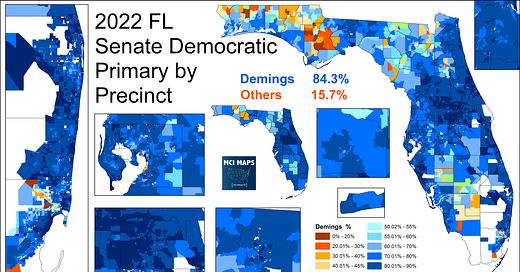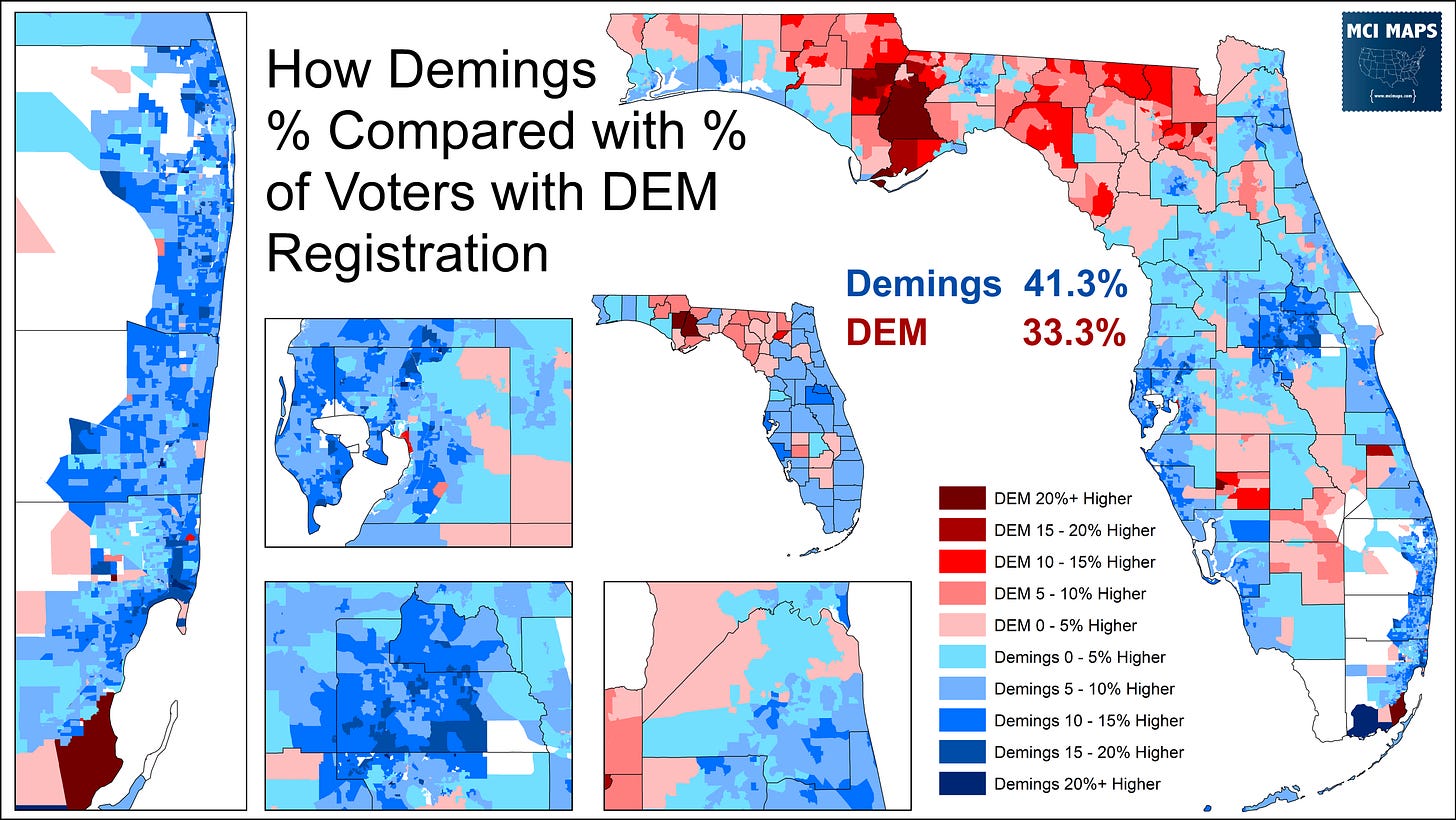Issue #105: Conservative Protest Votes in the 2022 Florida Democratic Primaries
Twilight of the Dixiecrats
In October of 2022, as Florida was about to go into its first general election with Republicans leading in voter registration, I wrote a post about the decline of the conservative “protest votes” in Democratic primaries.
You see, for decades, Florida Democrats led in voter registration, but this included a large number of very conservative, rural democratic voters. People who would vote Democrat for Sheriff or County Commission, but Republican for top-of-the-ticket races. I’ve covered this topic many times in my newsletter and main website.
Today, I want to circle back at the 2022 primaries and see what protest votes were left.
Background
As I mentioned in my October piece, the period of the 1990s through today is a period of Democratic decline in voter registration. This Democratic edge was strongest in North Florida, the land of conservative, yellow-dog democrats. Exactly like Democrats from Alabama or West Virginia. However, with time that North Florida registration has shifted more to the Republicans. See below.
So as I said, we have an entire batch of counties where the “Democrats” are more local, and they think that federal/state party has “gone too liberal.” So when primary day comes, and they wanna vote for Sheriff, they see a Senate or Governor primary for the Democrats, yet they know they will vote Republican in the general. So sometimes they leave it blank, or cast a ballot against the establishment candidate.
In 2012, Bill Nelson, who was popular with rural Democrats for much of his career, face a no-name opponent. Despite getting 78% statewide, he had much weaker showings in in rural counties.
Nelson would go on to win the general easily, and still outperformed in North Florida. However, his win there was much weaker than past contests. By his 2018 loss, that support with rural Florida had rapidly shrunk.
In 2014, I predicted that North Florida would be a sign of weakness for Charlie Crist, who faced a primary from liberal State Senator Nan Rich. Despite Rich’s efforts to paint the contest as left v former Republican, the Rich campaign had no real cash. I wrote, the night before the primary, that Rich would do best in the panhandle as a protest. I was right.
I did some follow-ups to this contest here. This race, and my prediction, sparked what is now an 8 year obsession with the issue. I was just out of grad school and trying to develop a name in the business at the time of the 2014 primary.
In the summer of that year, I distinctly remember being in a Wilton Manors Gay Bar, talking with Crist campaign staffers. I was in the county for a commission race, but Crist had a big presence in Broward County. I said “watch Charlie do worst in the panhandle” - a prediction based off looking at past primaries like 2010 or 2012. While some were intrigued, others brushed it off, claiming Crist’s role as a former Republican would boost him with conservative Democrats. I suspected Crist would only be viewed with distrust from these conservatives, who did not back his NPA bid in 2010. I remember on primary night waiting for the first returns from rural counties, knowing I’d look like a fool based on my article if I was wrong. When the results revealed the clear protest vote in North Florida, I was vindicated.
I also wrote about protest votes on several other instances. A short list.
Preview of 2016 Presidential Primary, includes look at protest votes in 2008
Preview of the 2020 Presidential Primary, more details on Protest votes from past cycles
This has become a topic of obsession for me for many years now. I doubt that will stop anytime soon.
Lets move on to 2022.
The 2022 Races
Florida had a few statewide Democratic primaries in 2022, but no race is better for tracking protest votes than the US Senate primary. Here, Florida 10th Congresswoman Val Demings had the nomination guaranteed. She faced three under-funded and unknown candidates - with Rocky de la Fuenta being a constant perennial candidate across several states. Heading into the primary, I was watching the totals for the other candidates to see how big the protest would be. In the end, Demings got 84% of the vote, but lost two counties in North Florida - Liberty and Holmes.
The results showed Demings underperform in rural communities - as well as the Cuban-heavy portion of Miami-Dade. North Florida is as expected, while the Cuban protest is partly an outcome of Hispanic names on the ballot coupled with growing Democratic decline with Miami-Dade Hispanic voters. Though it should be noted that in the 2016 US Senate DEM Primary (Murphy v Grayson), Fuente (who is always running for office) won many Hialeah area precincts then as well. Then in the general, Murphy did better with Hispanics than Demings would last year. So the Hialeah issues may related to both protests and name familiarity.
Below is the same US Senate contest, but rather has Demings running against all three opponents combined. In total, four counties saw Demings fall under 50% of the primary vote.
This was not the end of the protest vote, however.
Another method to examine protests by conservative democrats is to look at the undervote - aka ballots left blank. This has also been a common theme in this Democratic primaries. Statewide the blank ballots were 2.4%, but were much higher in the predictable areas.
The undervote can vary, depending what other contests are dragging the conservative Democrats to the pools. Back when local county offices in North Florida were dominated by Democrats, a primary for local Tax Collector or Sheriff would get more votes than the primary for Senate or Governor - with the topline just left blank. In 2022, most of these office are now held by Republicans, and Democratic primaries grow less and less. It is really telling how Liberty County still had 20% blank ballots when there was NO county-level office with a Democratic primary for these conservatives to show up for. School board races drove turnout there, and many conservative democrats just left these top-ballot races blank.
This local-race-driving-turnout can still be seen down in Miami-Dade. You may notice that darker orange blob in the center-top of the county. Is that Cuban voters? No. Its Caribbean voters. Specifically those in Dade Commission District 2 - which was home to a very crowded primary to replace the termed-out incumbent. The Caribbean-heavy North end of the district is the same area with a large undervote for Senate.
So what happened here? This seat is the county’s Caribbean-opportunity district, and as the race went on, there was strong efforts in the Caribbean, especially Haitian, community to get the vote out and ensure a candidate of their choice made the runoff. This was successful, as Marleine Bastien, born in Haiti, would win the November runoff. It is easy to see Haitian voters showing up to vote for this local race and giving much less attention to other statewide contests. It also doesn’t hurt that Caribbean voters are broadly more conservative than the Democratic caucus as a whole (though unlike rural whites in North Florida - they vote blue in the general).
One final way to look at the US Senate primary was to see blank ballots as a candidate. In total, Demings got 82% of the vote of registered democrats who bothered to show up.
Lets also take a look at the Governor primary.
The Democratic Primary for Governor proved to be a much bigger Crist win than many expected. The primary between Crist and Fried was very intense at times, but honestly if you’d been following the polling, it seemed clear Crist had the advantage. In the end, Crist would take the race, winning core Democratic blocks. Fried had some protest votes in North Florida, but also white liberals in areas like Jacksonville and broadly had student voters.
For Crist, the key was winning strong with black voters, Hispanics, and suburban whites, and retirees. Crist was especially strong with black voters in the primary.
The Governor primary does give us some protests to look at. Two other candidate, neither with name ID, were also in the running and secured 5% combined. Their vote shares were much higher in the same areas that rejected Demings.
The backing for these no-name opponents was another example of protest votes, albeit this was less than the protests for Demings. Fried actually managed to grab some of these protests, similar to Nan Rich from 2014 or Alan Grayson from 2016.
These protest votes do have predictive value for the general, especially the rural white breakdowns. Below is a map showing how Demings did compared to the share of the voters who were registered democrat.
Realistically, every candidate should outperform the % of the voters that is part of their party. If you get 90% of your party, and even just 30% of independents, you outdo your party share. Demings underperforming party share (and to be clear this constantly happens for Democrats in these counties) easily shows massive defections from the registered Ds in these areas.
Looking Ahead
As I said in October, we are definitely in a growing twilight for protest votes. These counties are continuing to see their voter registration move to the Republicans, meaning primaries have fewer conservative, rural, white democrats each cycle. This is occurring as local offices in the rural regions become more Republican. Liberty, for example, elected Republicans to local office for the FIRST TIME IN HISTORY in 2020.
In 2022, its two Democratic commissioners were re-election unopposed - as Republicans.
In fact, as I write this, Liberty County, the arguably last of the white “Dixiecrat” counties, has just a 13 person Democratic lead - out of just over 4400 voters. I mention this because I am working on an article that will come out once the registration flips - an article that delves deep into Liberty politics. This article will further explore the disconnect from the local and national scene for so many of these rural counties - and the realignment that has slowly trickled down-ballot.
















I have lived in St. Petersburg for 32 years, follow politics closely, yet Matthew continues to show me how much I still have to learn about how this strange state really operates. This report, in particular, was a huge eye opener. Thanks.